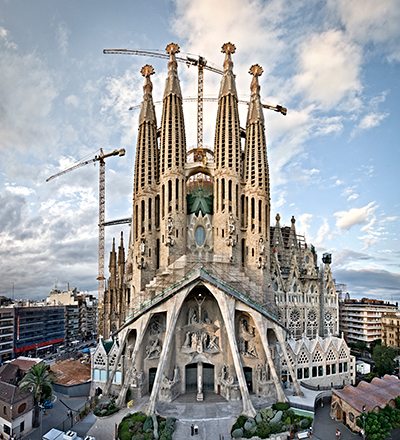Find below the ten most famous buildings in which the Spanish architect Antoni Gaudi worked during his long and distinguished career.
1. La Sagrada Familia
One of the most celebrated of Gaudi's works, La Sagrada Familia was begun in 1882 and continues to be under construction. Gaudi took on the project following the resignation of the original architect, Francisco de Paula Del Villar. La Sagrada Familia combines Art Nouveau and Gothic styles, with Gaudi so devoted to its construction that after his death, he was buried in the crypt. Gaudi completed around a quarter of the project during his lifetime, with hope that the project may finally be completed by 2026.
2. Casa Mila
Casa Mila, sometimes known as La Pedrera due to its popularity with locals, was constructed from 1906 and 1912. It was the final private home to be designed by Gaudi and is one of the most well known too, thanks to its eye-catching uneven appearance, as if the building had been carved directly from stone itself. Casa Mila was commissioned by Pere Mila, hence its name, and since 1984, Casa Mila has been named by UNESCO as a World Heritage Site.
3. Casa Calvet
Casa Calvet was constructed between 1898 and 1900, and this building is an example of some of Gaudi's earliest work. Casa Calvet was designed to be both a business premises as well as a private residential property too, with a textile business running from the ground floor and the basement. Situated in Eixample, one of the more architecturally conventional areas of Barcelona, Casa Calvet lacks some of Gaudi's usual outlandish style, however the projecting curved balconies and the double gable are unmistakably Gaudi.
4. Casa Vicens
Casa Vicens was built early in Gaudi's career, between 1883 to 1885, and was a commission for the Vicens family who wanted a summer house with a distinctive, architectural difference. As Gaudi's first project, Casa Vicens is an explosion of all of the architect's ideas and influences, with examples of Neo-Mudejar Moorish style, including neoclassical and oriental elements. Casa Vicens was constructed using tiles, iron and brightly coloured brickwork, and its horse-shoe archways and abstract mosaic design work are further examples of how much Gaudi had been influenced by the Neo-Mudejar style early in his architectural career.
5. Park Guell
Park Guell was designed and constructed from 1901 to 1914, and was commissioned by Eusebi Guell. Guell had previously commissioned Gaudi to design several other projects for him, and the estate of Park Guell came with several building stipulations and restrictions. The final construction could not interrupt the views down to the sea and the 17 hectares plus site only had permission for sixth of the area to be built upon. Nevertheless, Park Guell remains an enchanting and captivating park that echoes much of the naturalist style that Gaudi was so inspired by at this stage in his career.
6. Casa Battlo
Gaudi first began work on Casa Battlo in 1904, and it is often called the House of Bones, or Casa dels Ossos, by locals due to its skeletal appearance. Casa Battlo is considered to be of one of Gaudi's masterpieces, and incorporates many of his artist influences, including Art Nouveau, Modernisme and Neo-Mudejar. The exterior features rounded balconies, oval windows and intricate, vibrant mosaic tile artwork. The curved appearance of the roof of the building is made to represent a dragon, with the cross and the turret positioned to represent Saint George defeating the mythical beast.
7. La Colonia Guell
Commissioned once again by Eusebi Guell, the La Colonia Guell project was begun in 1898, with Gaudi beginning work on it in 1908. La Colonia Guell remains unfinished, but this place of worship retains much of Gaudi's signature style, with its curves and undulating brickwork featuring in the lower nave and the crypt. The construction was halted in 1914 following the passing of Eusebi Guell, however the building still remains a World Heritage Site to this day.
8. Palau Guell
Palau Guell is located in the El Raval area of Barcelona, and was another collaboration between Gaudi and his frequent commissioner and patron, Eusebi Guell. Palau Guell was constructed as a private residence from 1886 to 1888, and was a home designed for entertaining. Guests could enter via carriages through the parabolic archways, and the intricate ironwork and ornate interior as well as exterior are all typical Gaudi. The central entertainment area even includes tiny backlit holes in the ceiling, so that guests can enjoy a starlit sky aesthetic no matter the time of day.
9. Colegio Teresiano de Barcelona
Constructed between 1888 and 1890, Colegio Teresiano de Barcelona was a building that needed to be constructed on a minimal budget and already included a stone foundation and pre-prepared floor plan. As such, Gaudi added his own architectural flare mainly to the exterior design, featuring Moorish tiling and brick work, all in-keeping with the Modernisme style that Gaudi is so famous for. The Colegio designs were begun by priest San Enrique de Osso, and the austerity and straight lines remain, but Gaudi still managed to add his own creative flourishes, such as the points that top the crowns that can be seen on the building's façade.
10. Guell Pavilions
Guell Pavilions were constructed between 1884 and 1887, and are a series of buildings designed by Gaudi and commissioned by Eusebi Guell. The project began as a remodel of the original property that stood on the site, with Gaudi bringing his influences from Neo-Mudejar and Oriental architecture and design. There is also plenty of iron work, with the main gate shaped like a glassy eyed dragon, guarding the property. Guell Pavilions features three entrances in total, with the gatehouses, pavilion and stable constructed from yellow and red bricks along with coloured glass to reflect Gaudi's signature style, with illusions to dragon imagery present throughout the pavilion as well as the gardens too.




